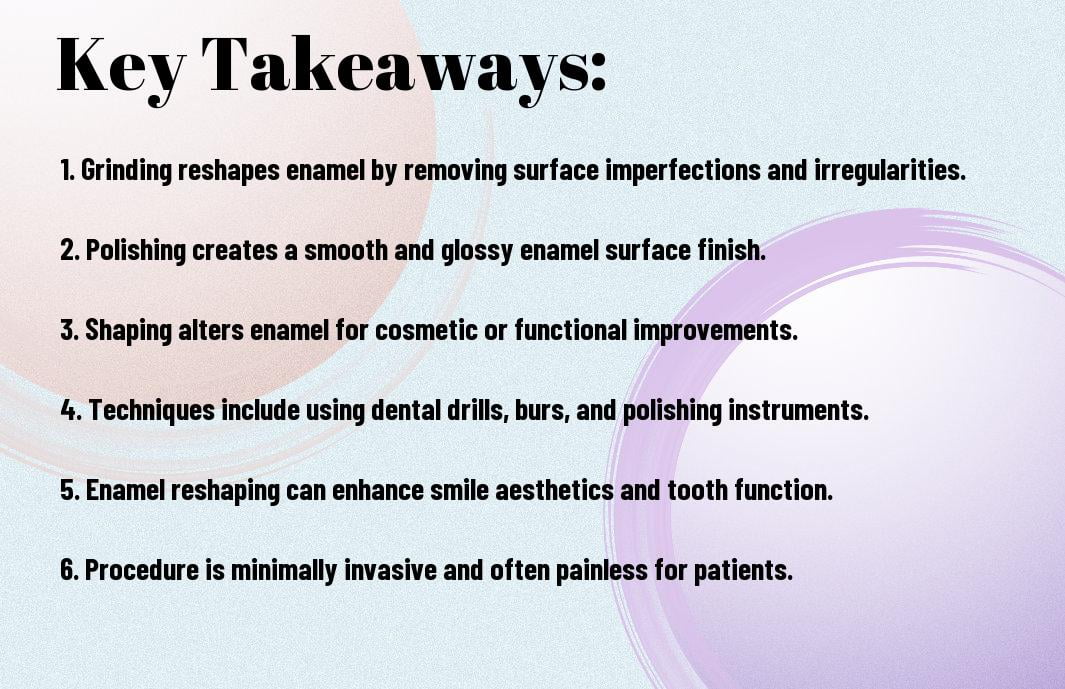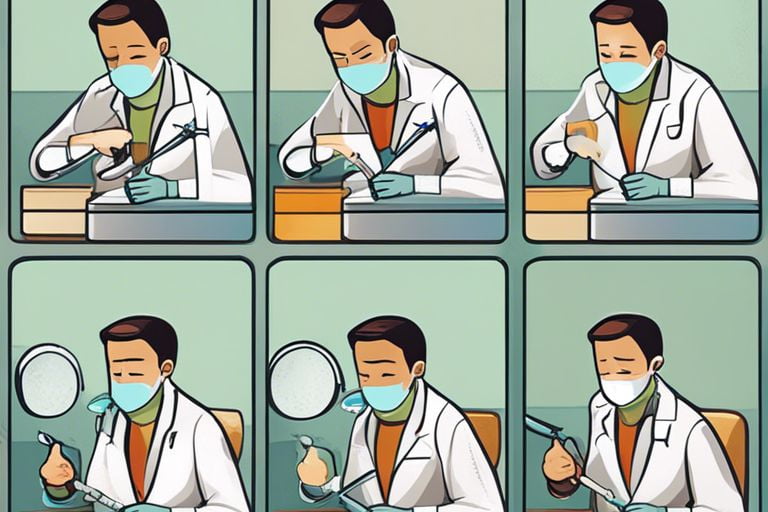Grinding, polishing, and shaping enamel are fundamental techniques in the world of dental care that you, as a dental professional, must master. Your ability to delicately reshape enamel can not only enhance a patient’s smile but also restore function and aesthetics. In this informative guide, we will examine into the precise methods and tools required for effective enamel reshaping. Let’s sharpen your skills and elevate your practice to the next level.
Key Takeaways:
- Grinding: Utilize diamond burs with care and precision to reshape enamel effectively, ensuring proper technique to avoid enamel damage.
- Polishing: Incorporate polishing techniques post-grinding to smoothen rough surfaces, providing a glossy finish and enhancing patient comfort.
- Shaping: Master the art of enamel shaping by combining grinding and polishing methods, enabling precise adjustments for improved dental aesthetics and functionality.
Fundamentals of Enamel Reshaping
Importance of Enamel Reshaping in Dentistry
For dental professionals like you, understanding the importance of enamel reshaping is crucial. Enamel reshaping, also known as enameloplasty, plays a significant role in improving the aesthetics and functionality of a patient’s teeth. By reshaping the enamel, you can correct minor imperfections, such as small chips or irregularities, and help patients achieve a more harmonious smile.
Anatomy of Tooth Enamel
Any dental practitioner knows that tooth enamel is the outermost layer of the tooth and is the hardest substance in the human body. Composed primarily of hydroxyapatite crystals, enamel protects the underlying dentin and pulp of the tooth from external stimuli and bacterial invasion. Understanding the structure of enamel is crucial for effective enamel reshaping procedures.
Another important aspect of enamel anatomy to consider is its unique translucency and light-reflecting properties. Enamel is responsible for the glossy appearance of healthy teeth, and reshaping techniques must preserve this natural beauty while addressing any imperfections.
Grinding Techniques
Some of the most important techniques for reshaping enamel involve grinding. Grinding is a crucial step in the enamel reshaping process as it helps to modify the shape and surface of the tooth enamel to achieve the desired result. This technique is commonly used in dental practices to address various enamel defects and imperfections efficiently.
Types of Grinding Tools and Their Applications
- Tools for grinding enamel come in various shapes and sizes, each serving a specific purpose in the reshaping process.
- Common grinding tools used in dental procedures include diamond burs, carbide burs, and stones, each tailored to different enamel reshaping needs.
- Diamond burs are ideal for precision grinding, while carbide burs are excellent for rapid enamel removal.
- Stones, on the other hand, are versatile and can be used for both grinding and polishing enamel surfaces.
- Any grinding tool you choose should be selected based on the specific enamel defect you are addressing.
| Tools | Applications |
| Diamond burs | Precision grinding |
| Carbide burs | Rapid enamel removal |
| Stones | Grinding and polishing |
Grinding Methods for Different Enamel Defects
The grinding methods used for different enamel defects vary depending on the type and severity of the imperfection. For instance, if you are dealing with a minor enamel chip or rough enamel surface, you can use a fine diamond bur for gentle grinding. However, for more significant defects such as enamel pits or deep grooves, a coarse carbide bur may be more effective in reshaping the enamel surface.
Safety Precautions for Grinding
Techniques for ensuring safety during the grinding process are critical to protect both you and your patient. When using grinding tools, it is important to wear protective gear such as safety glasses and a face mask to prevent any debris from entering your eyes or mouth. Additionally, ensure that the grinding tool is properly secured to minimize the risk of slippage and accidental injury.
Types
Types of safety precautions that should be taken during the grinding process include maintaining a steady hand and a stable working environment to prevent any mishaps. Always follow proper grinding techniques and guidelines to ensure a successful enamel reshaping procedure.
Polishing Techniques
Importance of Polishing in Enamel Reshaping
Reshaping enamel involves more than just grinding and shaping. Polishing plays a crucial role in achieving the desired smoothness, shine, and texture of the enamel surface. A well-polished enamel surface not only enhances the aesthetics of the teeth but also helps in preventing plaque accumulation and staining. Polishing is the final step that brings your enamel reshaping procedure to a professional finish.
Types of Polishing Agents and Their Uses
With polishing, you have various agents at your disposal to achieve the desired results. Different types of polishing agents are used depending on the enamel’s condition and the level of polishing required. Some common polishing agents include pumice, diamond paste, and fluoride-containing pastes. Each agent has its specific use and effect on the enamel surface, so choosing the right one is vital for the best results.
| Pumice | Removes surface stains and plaque |
| Diamond Paste | Provides a high-gloss finish |
| Fluoride-containing Pastes | Strengthens enamel while polishing |
- This selection of polishing agents allows you to cater to different enamel reshaping needs effectively.
Polishing Methods for Different Enamel Surfaces
Techniques for polishing vary based on the enamel surface you are working on. For smooth enamel surfaces, using a soft bristle brush with a gentle polishing agent is suitable to achieve a glossy finish without causing damage. In contrast, rough enamel surfaces might require more abrasive polishing agents to smoothen the surface effectively. It’s important to select the right method for each surface to ensure optimal results in enamel reshaping.
Plus, considering the patient’s oral health habits and preferences can also guide you in choosing the most appropriate polishing method for their enamel. By taking these factors into account, you can personalize the enamel reshaping process to meet the unique needs of each patient.
Shaping Techniques
Principles of Enamel Shaping
An vital aspect of reshaping enamel is understanding the principles that govern this process. When shaping enamel, you must always consider the structural integrity of the tooth and ensure that the final shape is both functional and aesthetically pleasing.
Shaping Tools and Their Applications
An important part of mastering enamel shaping is becoming familiar with the various tools used for this purpose. From diamond burs to finishing discs, each tool serves a specific function in the shaping process, allowing you to achieve precise results.
Understanding the applications of each shaping tool is crucial for achieving optimal results. For example, diamond burs are efficient for initial reduction, while finishing discs are ideal for refining the surface texture of the enamel.
Shaping Methods for Different Tooth Structures
Principles of enamel shaping vary depending on the tooth structure you are working with. Different techniques are required for reshaping incisors, canines, premolars, and molars to ensure both functionality and aesthetics are preserved.
Enamel shaping methods must be adapted to suit the specific characteristics of each tooth structure. For instance, when reshaping incisors, you need to focus on symmetry and balance, while reshaping molars requires attention to occlusal relationships and intercuspal contacts.
Combining Techniques for Optimal Results
Grinding and Polishing Combinations
To achieve the best outcomes when reshaping enamel, combining grinding and polishing techniques is crucial. Starting with grinding to reshape the enamel surface followed by polishing helps to refine the surface texture and restore a smooth finish. By using a sequence of finer abrasive materials during polishing, you can achieve a polished enamel surface free from any irregularities or rough patches.
Shaping and Polishing Combinations
Results from combining shaping and polishing techniques can provide precise and aesthetically pleasing enamel contours. Shaping the enamel initially allows you to adjust the tooth’s structure to the desired shape. Follow this with polishing to not only smoothen the surface but also enhance the natural shine of the enamel. This combination creates a beautifully contoured tooth that fits seamlessly with the patient’s smile.
Plus
Advanced Techniques for Complex Cases
With advanced techniques, you can address even the most complex cases of enamel reshaping effectively. Utilizing specialized tools and skills, you can achieve remarkable results in restoring the shape and appearance of teeth. Here are some advanced techniques you can consider:
- Microabrasion: Using precise microabrasion techniques to target specific areas for reshaping.
- Laser-assisted Contouring: Employing innovative laser technology for precise shaping and contouring of enamel.
Combining different techniques tailored to each specific case allows for customized and optimal results. By incorporating these advanced methods into your enamel reshaping procedures, you can achieve outstanding aesthetic outcomes for your patients.
Common Challenges and Troubleshooting
Dealing with Enamel Sensitivity
Not all patients have the same tolerance level when it comes to enamel reshaping. Any signs of enamel sensitivity should be addressed promptly. If your patient experiences discomfort during the procedure, consider using a desensitizing agent or opting for a gentler approach to minimize any potential discomfort.
Managing Enamel Fractures and Cracks
One of the common challenges you may encounter while reshaping enamel is managing fractures and cracks. If you notice any signs of enamel damage, it is crucial to assess the extent of the issue before proceeding. In some cases, minor fractures can be smoothed out during the reshaping process, but more significant cracks may require additional treatment such as bonding or filling.
Enamel reshaping can sometimes reveal underlying cracks or weaknesses that were not initially visible. If you encounter a situation where the enamel is compromised, communicating this to the patient and recommending appropriate follow-up care is important to prevent further damage.
Overcoming Common Shaping and Polishing Errors
On occasion, despite your best efforts, shaping and polishing errors may occur during enamel reshaping. These errors could include uneven surfaces, overgrinding, or inadequate polishing. If you notice any imperfections, take the time to reassess your technique and make any necessary adjustments. Utilizing different polishing tools or techniques can often help correct these errors and achieve a smoother, more uniform enamel surface.
Common shaping and polishing errors can be frustrating, but they are also valuable learning opportunities. By analyzing the mistakes and understanding their root causes, you can refine your skills and improve your overall proficiency in enamel reshaping procedures.
Summing up
So, now you have learned about the various techniques for reshaping enamel – grinding, polishing, and shaping. These methods play a crucial role in enhancing the aesthetics and functionality of teeth, making them necessary skills for any dental professional. By mastering these techniques, you can transform smiles and improve the oral health of your patients.
Be mindful of, practice makes perfect, so keep honing your skills and stay up-to-date with the latest advancements in dental technology. Your dedication to learning and improving will not only benefit your patients but also enhance your reputation as a skilled and reliable dental professional.
FAQ
Q: What are the techniques commonly used for reshaping enamel?
A: The techniques commonly used for reshaping enamel include grinding, polishing, and shaping. These procedures are vital in cosmetic dentistry for improving the appearance of teeth.
Q: How is grinding enamel done in dental procedures?
A: Grinding enamel in dental procedures involves using a dental drill with various attachments to carefully remove small amounts of enamel. This process requires precision and expertise to ensure the tooth is reshaped effectively without causing damage.
Q: Why is polishing enamel important in dental reshaping?
A: Polishing enamel is crucial in dental reshaping as it helps smoothen the surface of the tooth after grinding and shaping. This step enhances the aesthetics of the tooth and reduces the risk of plaque buildup, contributing to overall oral health.







